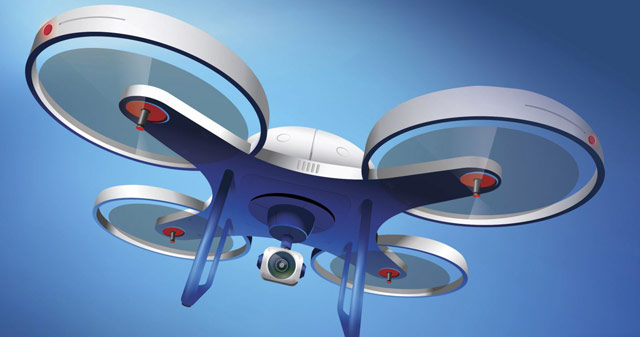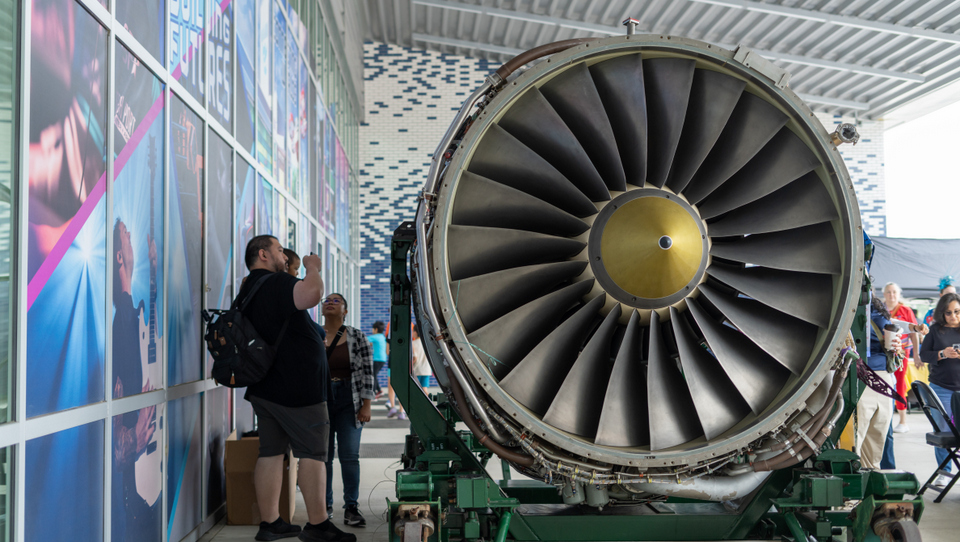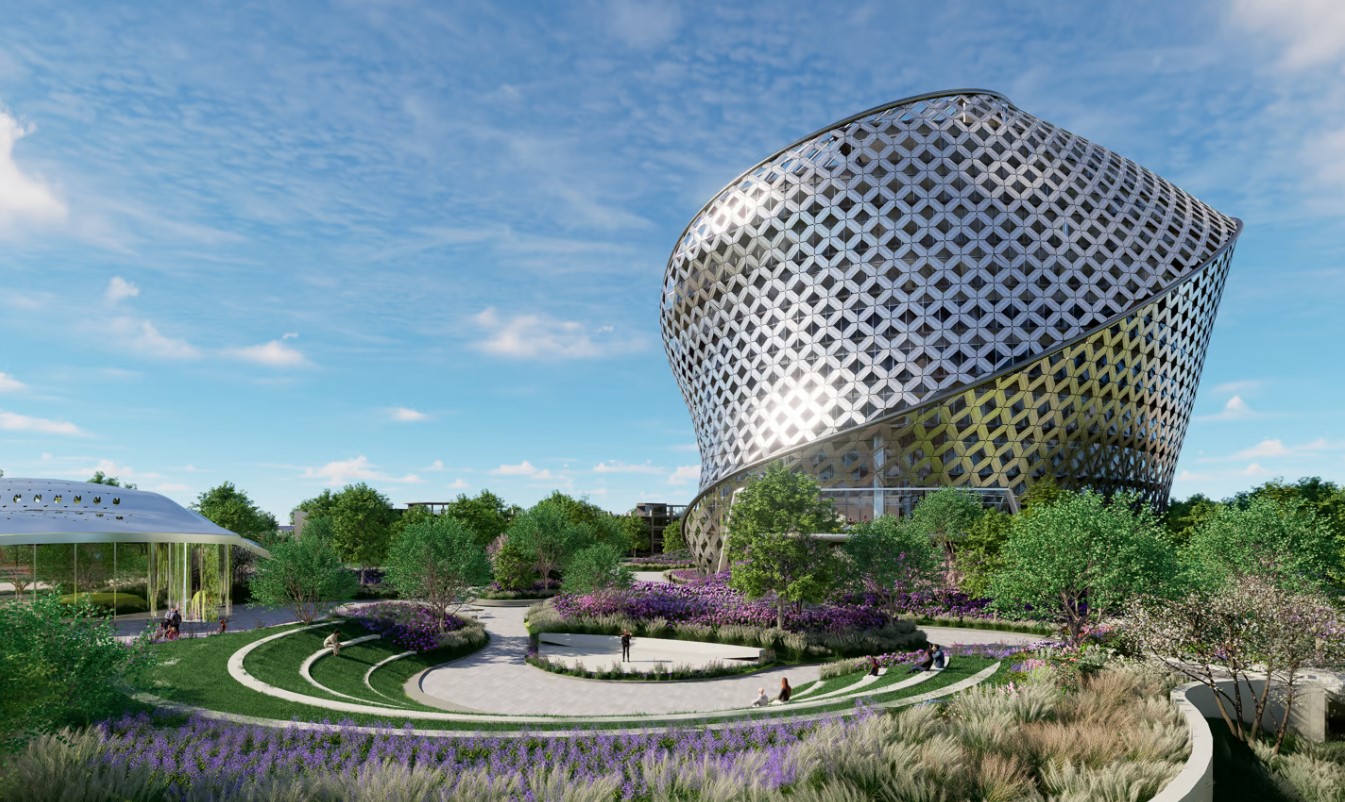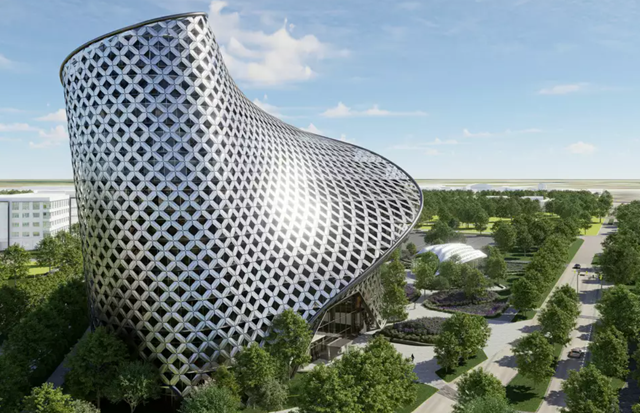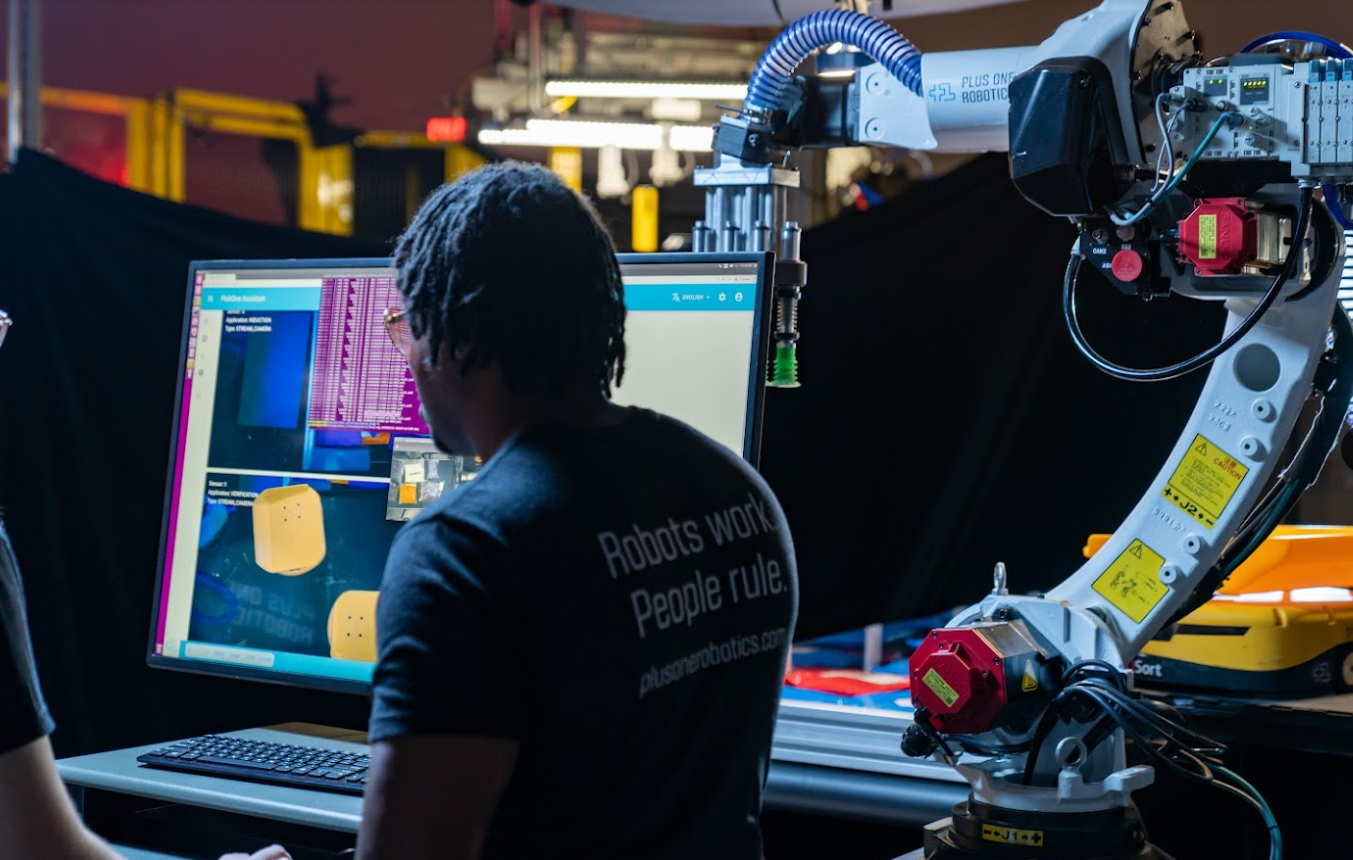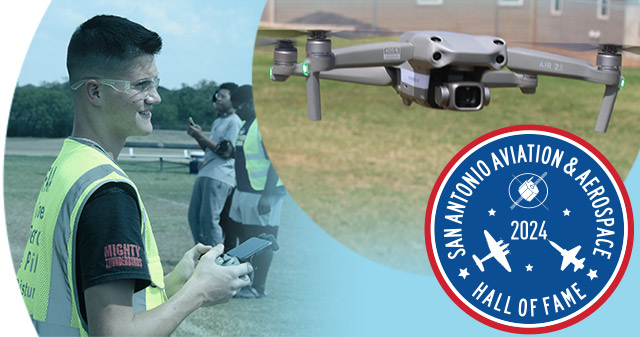10-17-2023
Downloadable Version

Running out of room: As Port San Antonio faces latest space crunch, it looks to an 'elevated' future
(REPRINTED UNDER LICENSE FROM THE SAN ANTONIO EXPRESS-NEWS VIA COPYRIGHT.COM)
By Eric Killelea, Staff Writer - San Antonio Express-News
The city’s largest technology hub is nearly out of space.
Port San Antonio CEO Jim Perschbach recently declared — optimistically — there’s “almost no vacancy” on the sprawling 1,900-acre campus he oversees.
But the fact 96 percent of the port’s 8.2 million square feet of facilities is occupied isn’t hindering his plans for growth. In the next five to 10 years, Perschbach said, the number of people heading to work at the former Kelly Air Force Base campus each day will double.
It’s a tall order.
The port now has more than 80 tenants with 18,000 workers. While there’s about 2 million square feet of facilities space in former Air Force structures, they’re considered “obsolete” for port use because they are historic buildings being preserved.
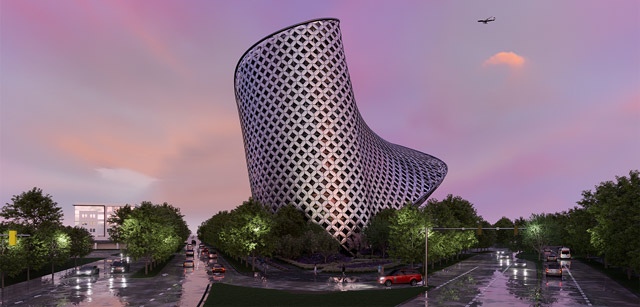
A conceptual rendering of Port San Antonio's planned office tower. Image credit: Pelli Clarke & Partners.
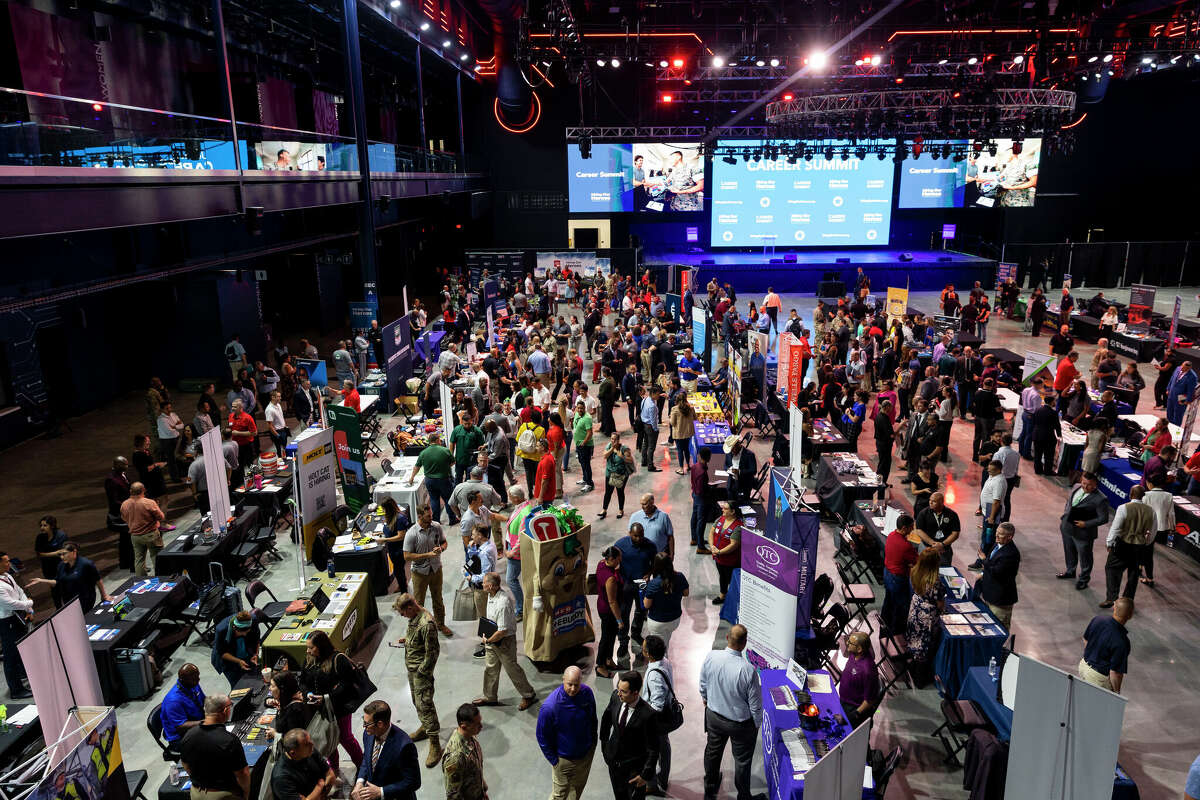
Job seekers and recruiters mingle during the US Chamber of Commerce and Joint Base San Antonio Career Summit at the Boeing Center at Tech Port San Antonio in San Antonio, Texas, on Aug. 2, 2023. Image credit: Josie Norris/San Antonio Express-News.
Since 2017, though, the port has built 750,000 square feet of space both in new buildings and by converting non-historic existing properties to accommodate 8,000 new employees.
Now, Perschbach is aiming to build out the port’s remaining 800 acres to make space for the steady flow of companies heading there to be closer to clients in aerospace, manufacturing and, increasingly, the city’s intelligence community and Air Force cyber units based at nearby Joint Base San Antonio-Lackland. About half of that 800 acres is already open for development and the other half will be after demolition of non-historic existing buildings.
By investing in such efforts, Perschabach said, the campus will add another 12,000 to 18,000 employees in the next five to 10 years.
“It’s a city that we’re going to be putting in here,” he said.
Decades of Growth
The port has been growing for more than two decades to reach this point.
After the Base Realignment and Closure Commission announced in 1995 that Kelly Air Force Base would be closed, the city of San Antonio formed the nonprofit port authority to own, operate and redevelop the site’s inland port facilities for air, trucking and rail transportation. When the 4,017-acre base was shuttered in 2001, about half its land was transferred to the adjacent Lackland Air Force Base. The other half went to the port to support growth of the regional economy.
While it was created by government and is overseen by an 11-member board of directors appointed by each member of the City Council, the port is operationally independent. It has no taxing authority and receives no governmental funds.
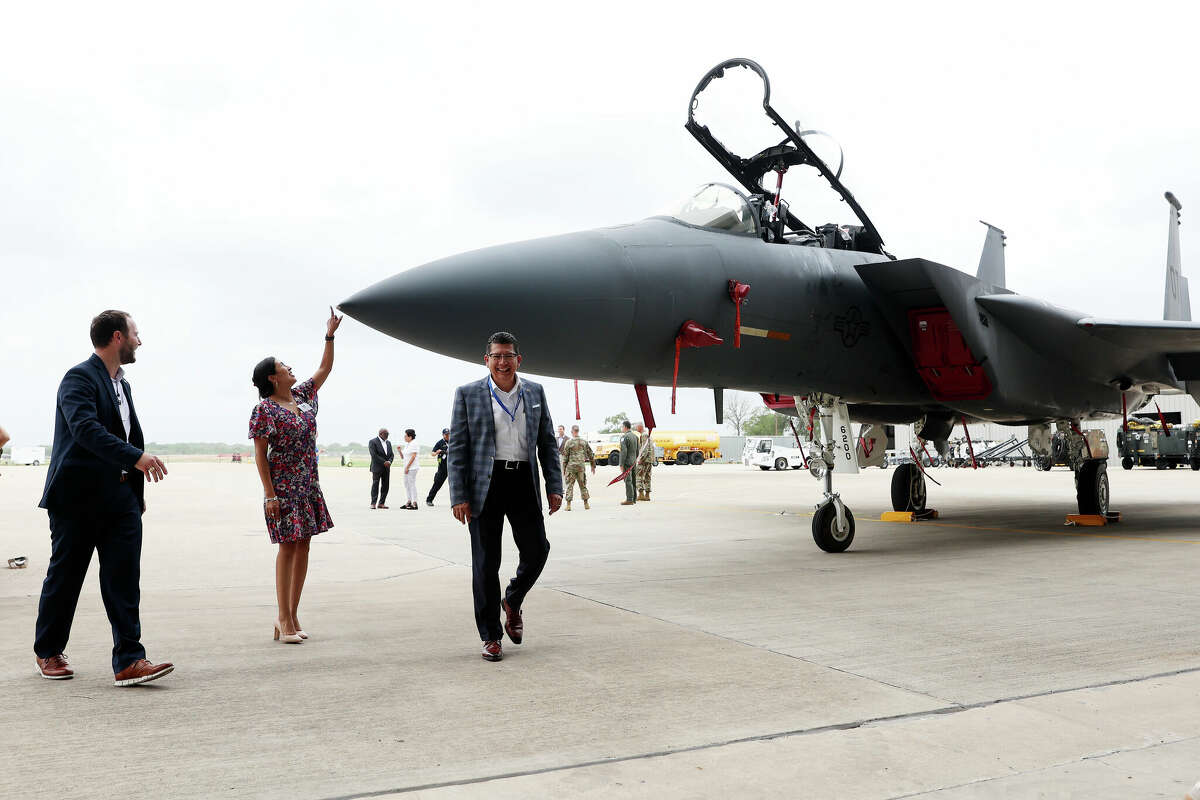
San Antonio City District 4 Councilwoman Adriana Rocha Garcia, center, reaches to touch the nose of a F-15E fighter jet after an induction ceremony at Boeing North Campus in July 2022. With Rocha Garcia are Boeing Senior Manager for Government Operations Tyler Schroeder, left, and San Antonio Chamber of Commerce CEO Richard Perez. Image credit: Jerry Lara/Staff photographer
“We are a strange creature,” Perschbach said. “We are a political subdivision of the state of Texas, but we operate like any other real estate development company. We get no tax dollars and so we have to use our assets and our employees to generate revenue, just like any other developer.”
Perschbach took on the role of breathing new life into those assets when he became CEO in early 2018. In fiscal 2017, the port reported revenue of $33.8 million, a decline of more than 20 percent since 2013, and with some projects reportedly behind schedule.
Now, heading into fiscal year 2024 the port has budgeted revenue of about $75 million and its borrowing capacity is north of $500 million, up from $75 million in 2017.
“We had massive amounts of vacant buildings and most of this complex was sitting completely empty,” Perschbach said. “Now, we’re filling that in and as we’re adding value and our customers add value to the building, your ability to use that as collateral to get a loan goes up, which allows us to build new buildings. That then adds to our asset base which adds to our revenue model which allows us to generate more borrowing capacity, more revenue and invest that back into the campus.”
Recent Additions
Paco Felici, the port’s spokesman, said the success of the strategy is reflected in the recent announcements by three technology companies to set up operations on the campus.
Within the past month, there have been location announcements from IT and cybersecurity firms IntelliGenesis, Leidos Holdings Inc. and General Dynamics Information Technology. All have operations in the city but leased space on the campus to be closer to clients and others in the port’s growing tech community.
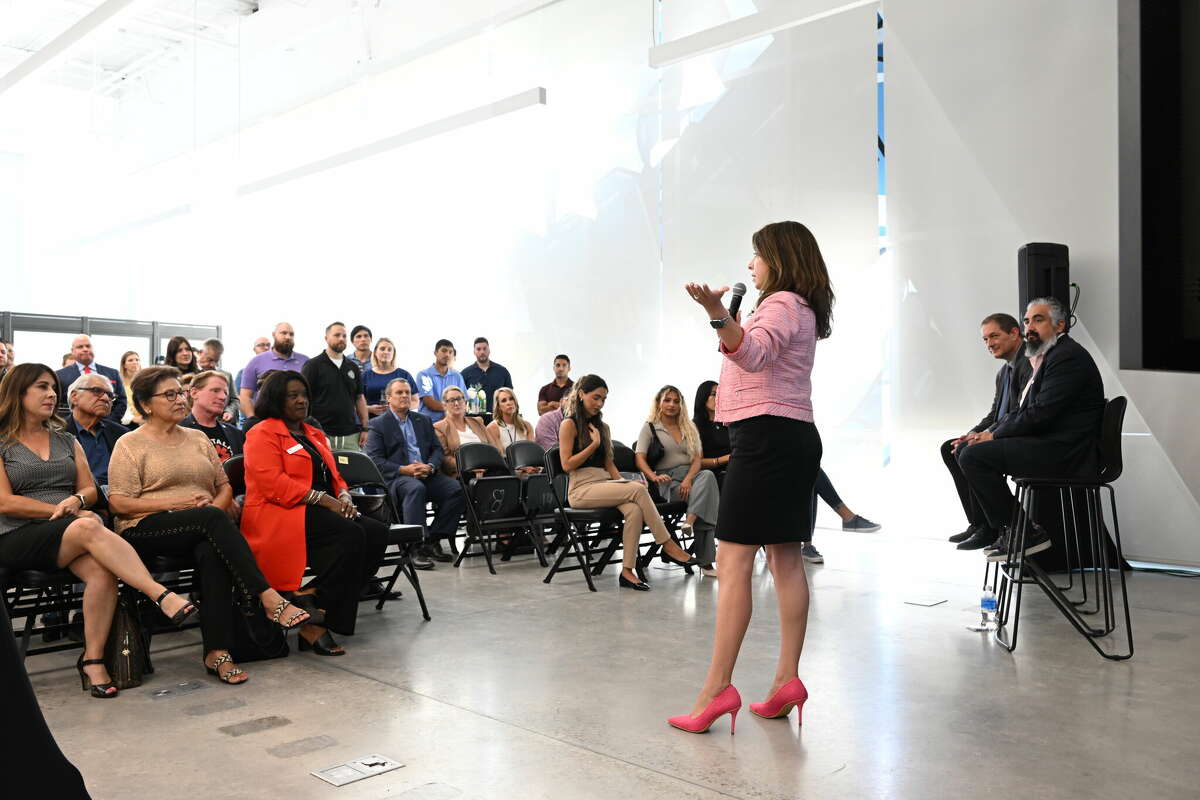
Angie Lienert, founder and CEO of IntelliGenesis, speaks in front of a crowd at Capital Factory. Image credit: Port San Antonio/Photographer Mark Sobhani
“For us, it was about being in the space close to the customers so they can come to our facility, or we can go to theirs,” said Anil Tailor, a senior vice president at Leidos. Angie Lienert, founder and CEO of IntelliGenesis, put it this way: “We’re interested in being able to diversify with the Air Force customers down here and some of the other customers as well,” she said. “It’s a great place for us to grow.”
Perschbach said the combination of improved facilities and the access the port provides to clients at JBSA and intelligence communities across the city makes the property more valuable.
“The strategy was we wanted to improve the product offerings that we had at the campus to attract customers that were willing to pay a higher price to be here,” Perschbach said. “That allows us to continue to improve the campus to keep moving at above the market.”
But the goal isn’t just generating more revenue, he said. It’s creating jobs and more reasons for firms to locate in the San Antonio area.
“The old strategy was to offer land and space really, really cheap, incentive everybody. But when you do that, you don’t have a lot of jobs and they don’t pay very well,” he said. “We’re bringing in companies that are paying much higher and creating a lot more opportunities across the spectrum within the growth in that industry.”
It doesn’t hurt that while San Antonio now has the nation’s largest cybersecurity workforce outside of Washington, D.C., leasing options at the port are much less expensive.
“Everybody knows that there’s a hub of military presence in San Antonio,” said Peter Lambert, vice president of the General Dynamics Information Technology’s unit whose portfolio includes the Air Force. “Port San Antonio is filling the void that Kelly Air Force Base vacated, and the facilities being developed there are fantastic. It’s as close as we can be with the customers. It’s all very attractive.”
Historic Buildings
While the port has been able to build on large chunks of the land it inherited from the military, many Kelly-era buildings still present challenges because of the need for major renovations or have been deemed unusable for a variety of reasons.
The campus is home to what Perschbach describes as “old military-type buildings” including aircraft hangars and engine overhaul facilities. The port has modernized some of those to create spaces for tenants such as aerospace companies Boeing Co. and StandardAero, but many others “just aren’t useful anymore,” so there has been a wave of demolition projects.
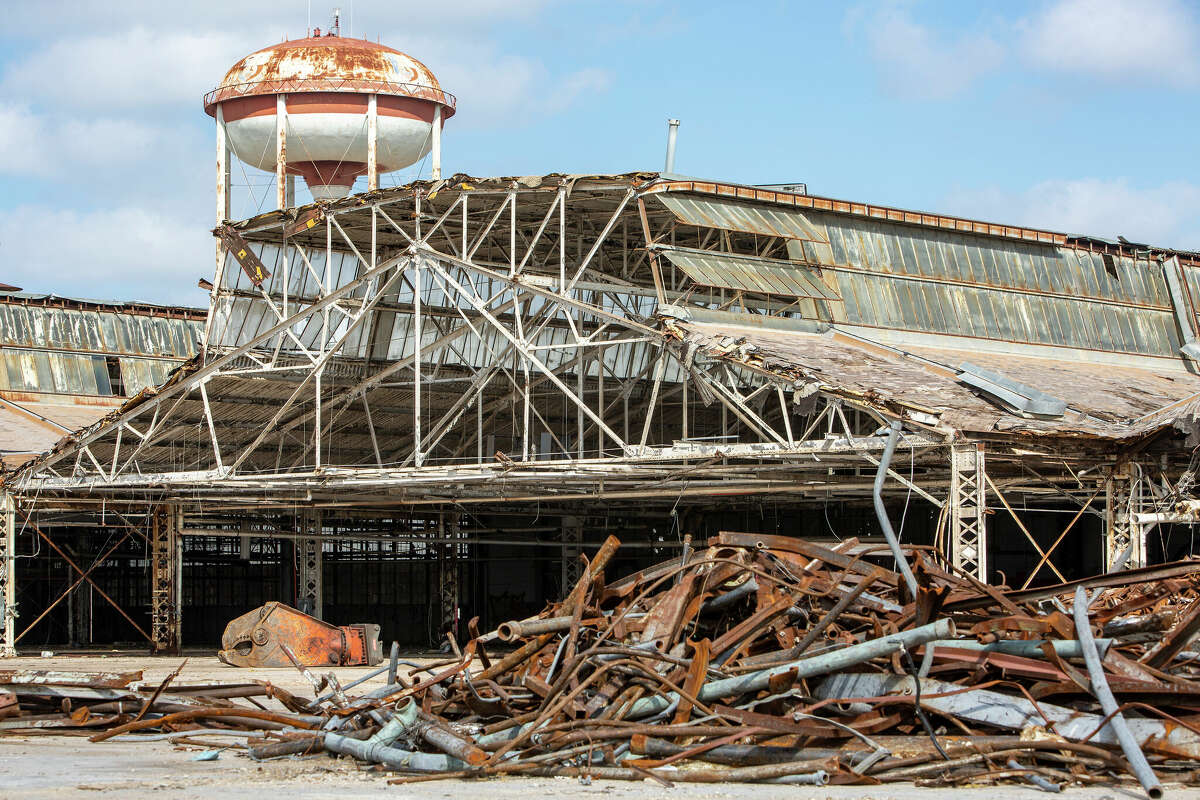
Demolition of the former Air Force hangar at the intersection of Old Street and Perrin Road as seen on November 10, 2022. Image credit: William Luther/Staff
The campus is also home to some “very historic buildings” that will never be demolished, he said. They include the Bungalow Colony built in 1918 to house military officers and their families. Structures there are among several on the property that are listed on the National Register of Historic Places.
The port last year partnered with the city of San Antonio’s Office of Historic Preservation to install its Living Heritage Trades Academy and Material Innovation Center to train people in traditional crafts and skills restoring the colony.
The last big category of sites includes new buildings Perschbach said are “designed to house and attract the type of work we’re bringing to the campus and change the image of the campus.”
Some of the latest tenants have gone into new buildings begun in the past five or six years. At the same time, the port has been itching to replace the base’s old “creech brown” warehouse-type infrastructure with new buildings “to attract people to spend time together and get to know each other.”
Rapid Expansion
Space crunches aren’t a new challenge for the port. In 2017, its existing office space was near full occupancy, leaving it with less than 40,000 square feet available for a flurry of newcomers.
That’s why the port that year broke ground on a 90,000-square-foot office building tailored for cybersecurity companies. The $20 million project is known as Project Tech, a development that’s continued to grow, Perschbach said. Lockheed Martin, the aerospace giant, became the first tenant in 2018.
After quickly filling that first building, the port in 2019 approved construction of a $50 million, 174,000-square-foot dubbed Project Tech Building 2.
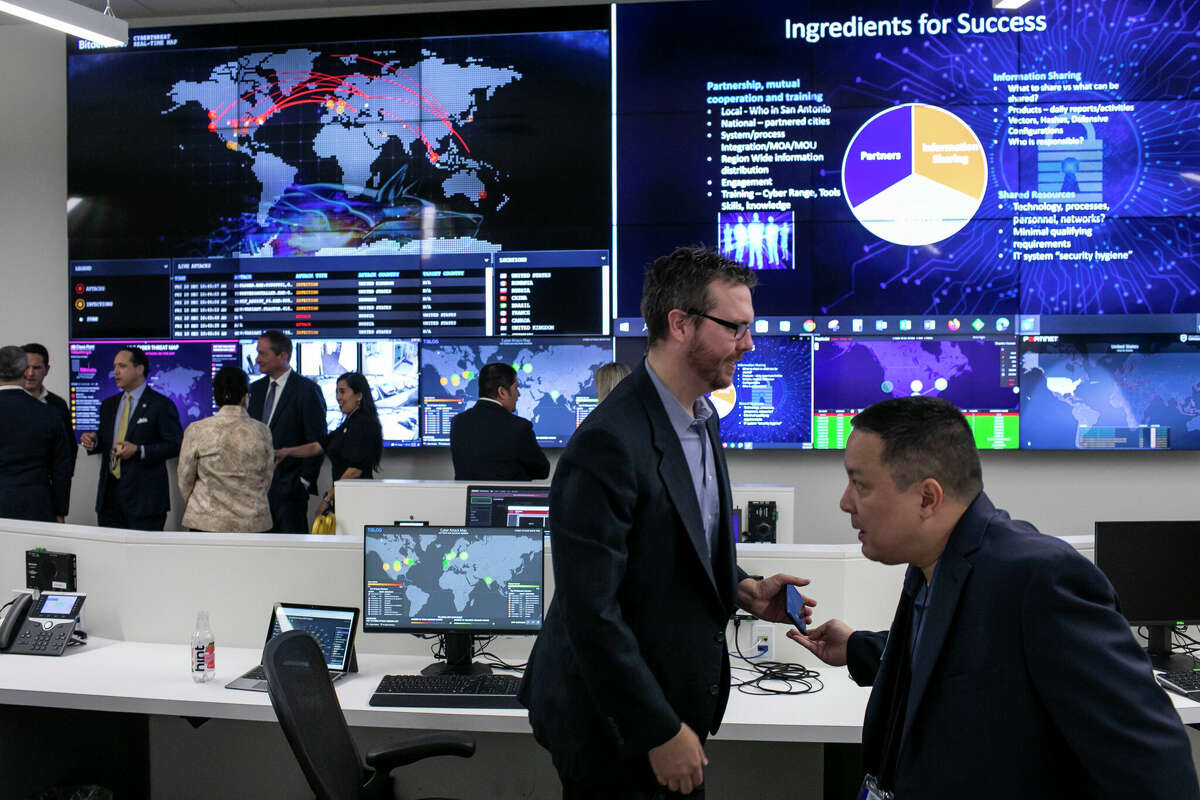
Team members work in the Alamo Regional Security Operations Center at Port San Antonio. Image credit: Josie Norris/San Antonio Express-News.
Between 2018 and 2020, the port added 3,000 jobs to reach 14,000 people on campus each day working in cybersecurity, aerospace, defense and manufacturing.
It also pursued millions of dollars worth of capital projects to improve the campus. The city of San Antonio issued a $24 million bond to provide drainage infrastructure. The San Antonio Water System provided $4 million for sewer infrastructure improvements. The port also spent $1 million to create digital signage visible from General Hudnell Drive and 36th Street.
Last year, the port celebrated the opening of its largest project to date: the $70 million, 130,000-square-foot high-tech concert and esports venue then known as Tech Port Center + Arena.
In January, after months of hosting musicians, gaming competitions, robotics events and cybersecurity and military networking conferences, Boeing paid an undisclosed amount to rebrand the center as the Boeing Center at Tech Port. Gov. Greg Abbott and Mayor Ron Nirenberg attended the rebranding event along with dozens of military officials.
“The Boeing Center is going to start turning a profit,” Perschbach said recently. “It’s not there yet, but it takes a while to build the business.”
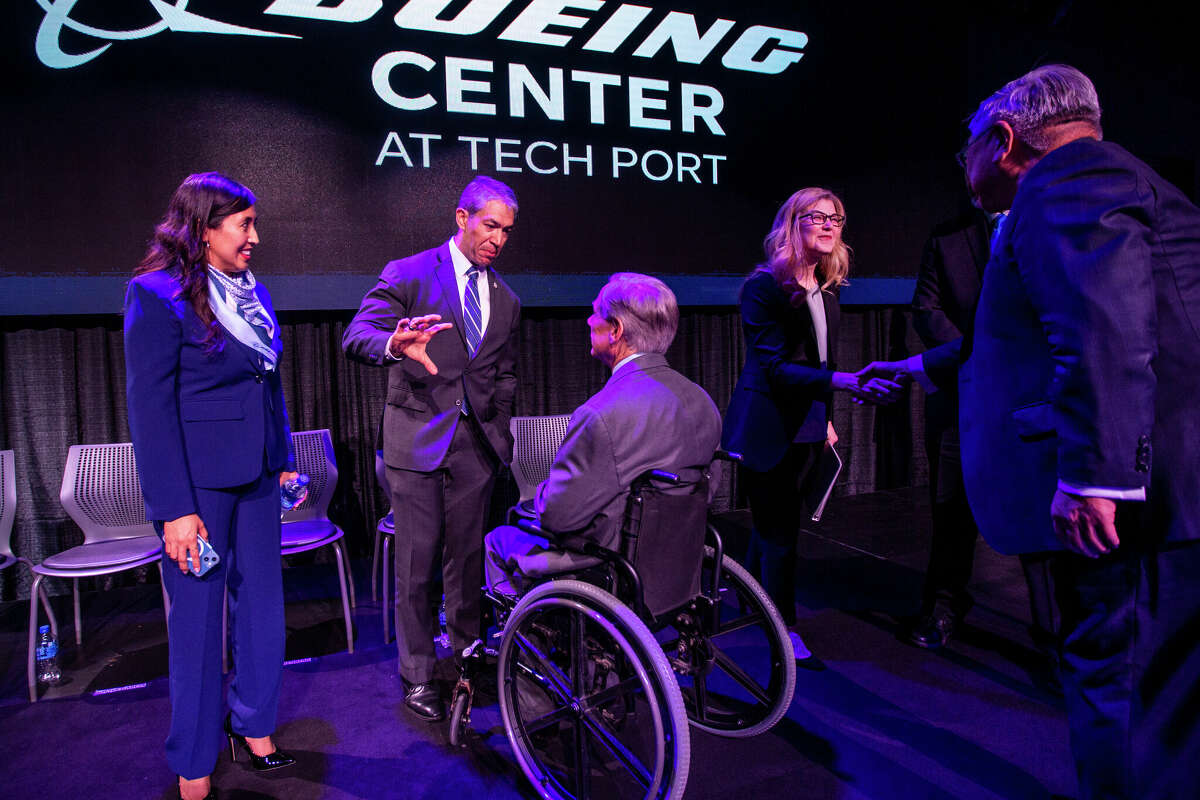
San Antonio city council member Adriana Rocha Garcia, from left, Mayor Ron Nirenberg, Texas Gov. Greg Abbott, Stephanie Pope, Executive Vice President of The Boeing Company and president and chief executive officer of Boeing Global Services and Bexar County Judge Peter Sakai talk Tuesday, Jan. 24, 2023, after it was announced the Tech Port Center would be renamed the Boeing Center at Tech Port in a seven year naming rights deal. Port San Antonio, Boeing, and ASM Global, the company managing the facility for Port San Antonio, all declined to say how much Boeing paid for the rights. Image credit: William Luther/Staff
Profit from events at the center are directed to the Kelly Heritage Foundation, an educational nonprofit affiliated with the port. Boeing also promised $2.3 million to the foundation over seven years in a separate agreement to expand STEM programs and workforce development.
In June, the port announced another milestone: Its tenants created more than 2,000 jobs in fiscal year 2023 to increase the workforce on campus to 18,000 — roughly doubling the tally under Perschbach’s tenure.
“We don’t want to just be bringing in new people for these jobs we’re creating,” he said. “We want to create new opportunities for the people in San Antonio to fill these jobs.”

Guest take cheering and taking photos at the start of the Smashing Pumpkins show at the Boeing Center on May 2, 2022. Image credit: Ronald Cortes / Contributor.
‘Far-fetched Dream’
San Antonio Councilwoman Adriana Rocha Garcia, who represents the South Side district that includes the port campus, said she speaks with Perschbach at least three times a week about capital projects and events.
“Sometimes it seems like a far-fetched dream — and then he achieves it,” she said of Perschbach’s goals.
Rocha Garcia said the promise of tens of thousands of jobs over the next decade will benefit residents in her district and beyond.

People work together to move a background sign during the US Chamber of Commerce and Joint Base San Antonio Career Summit at the Boeing Center at Tech Port on August 2, 2023. Image credit: Josie Norris/San Antonio Express-News
She says she can “hear enthusiasm” from constituents interested in applying for the port’s high-paying jobs and those who head to the Boeing Center for concerts, boxing matches and other events, or take their children to visit the LAN Gaming Center or San Antonio Museum of Science and Technology.
“That’s an opportunity that they hadn’t had before, that I think is really helping, and Jim has really been pivotal to bringing all those connections,” Rocha Garcia said.
It reminds some longtime families of “the good old days” of when the Kelly Air Force was bustling with airmen and civilian workers, she said.

One of Plus One Robotics' products is displayed Wednesday, Oct. 30, 2019 before a ribbon cutting ceremony for the company's new 11,000 square foot Port San Antonio facility. Image credit: William Luther/Staff.
But Rocha Garcia acknowledged many companies on campus are seeking employees with technology skills and U.S. top secret clearances that are not obtainable by many of her constituents. But they can dream, too.
“Some think it’s too late for them, but for their kids it’s a perfect opportunity,” she said.
Saying it was attempting to bring more jobs and prestige to the city, the port earlier this year revealed conceptual plans for a futuristic wing-shaped office tower that could be from 12 to 15 stories high. When the idea for a “signature” office building for the port was announced in 2022, officials said it would house the headquarters for DeLorean Motor Co., which is already a port tenant.
It could also include a vertiport for electric vertical takeoff and landing vehicles — a cross between fixed-wing aircraft and helicopters and other high-tech amenities. It’s slated to be completed in early 2025.
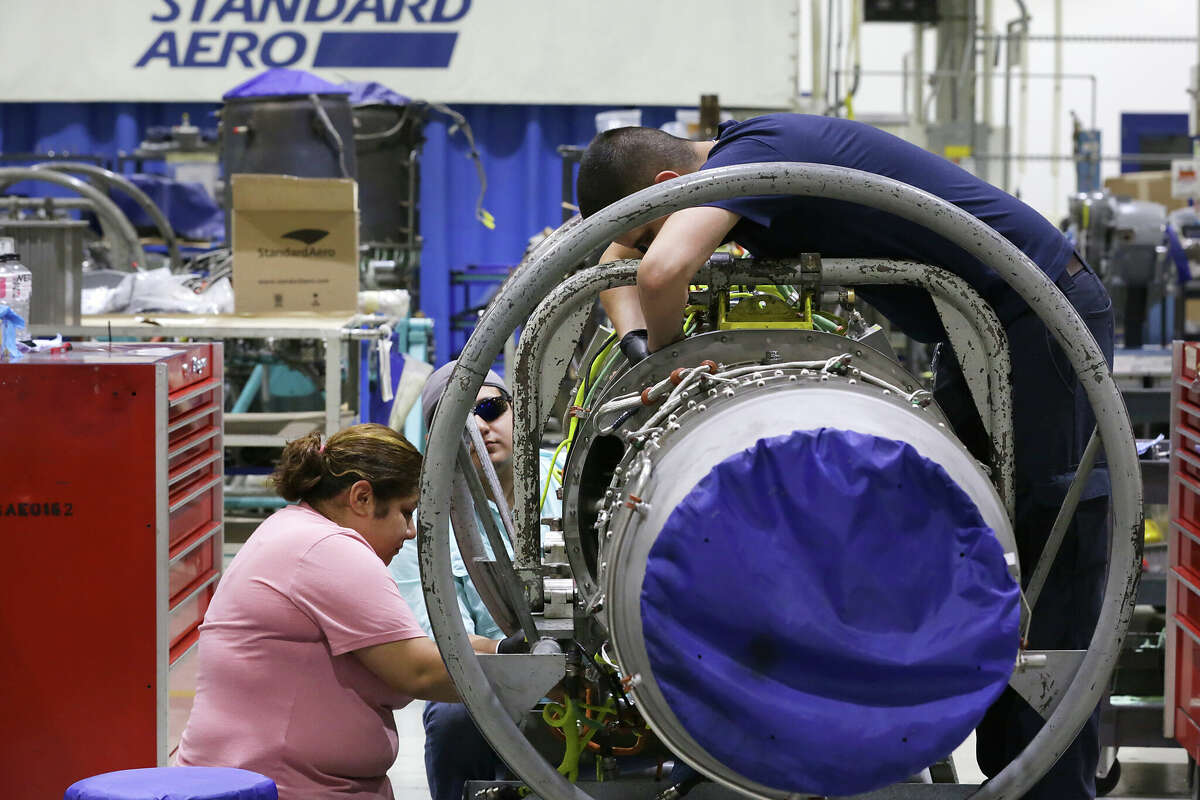
Workers at StandardAero refurbish a T 56 engine at their offices at Port San Antonio, where massive job growth has been seen in the last two years. Image credit: Bob Owen/Staff photographer.
Discussing the new building recently, Perschbach stopped for a moment to consider the evolution of buildings already on the port campus. The original Project Tech building, he said, remains a “a very nice building but it’s dramatically overshadowed” by the Project Tech Building 2 — and that more recent construction will be “completely blown away” by the planned tower.
“We’re trying to do everything that we do up,” he said. “It’s a constant motion and the hope is that as we do that, not just the areas around us but the entire city is elevated with us. … I’m not so arrogant to say we’re elevating the entire city, but we’re connecting these opportunities and giving them a platform.”
BANNER IMAGE: Conceptual rendering of a reimagined Port San Antonio. Credit: Port San Antonio.

